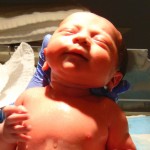
It’s never too late for healing, as shown by the example of Caesarean section.
The two most important events in human life are birth and death – moments of passage. Both the “arrival” and “departure” should be carefully planned and are governed by certain rules.
The childbirth may be “premature”, “late” or “too quick”. “Too quick” childbirth may be a difficult experience for the Spirit, since during vaginal delivery it attempts to merge with the Child’s physical form. The consequences of “too quick” childbirth, for instance the Caesarean section, include physical and mental difficulties that resonate in adult life.
Childbirth: Sudden, unexpected
The Caesarean section is an experience where the internal pregnancy course is interrupted. The child in the mother’s womb prepares to arrive into the world and at the same time, an “Alien” attempts to bring the child out of the womb.
The child’s instinct is to push and shove, because if it doesn't, it won't be born. To get out of the confined space of the “uterus” is the child’s central need.
The interrupted pattern of “pushing for exit from the mother’s womb” may result in the following disorders in adult life:
As children, those persons dislike hugging
As adults, those persons have difficulties in establishing and maintaining close relationships. When those persons start to feel loved, the old pattern of avoiding intimacy “takes over”, creating an urgency to leave the other person. Of course, as soon as they abandon their loved ones, they feel an immediate urgency to return “into their arms”. Usually, however, it’s too late. A young woman, who broke up with her boyfriend 6 times, was eventually “abandoned” by her partner who “was sick of being dumped.”
An overwhelming need to immediately break the relationship as soon as they start forming an intimate, close contact with the other person. Such persons need to know where “exit route” is and always keep an eye on it
The persons who experience a “too quick, rapid” delivery, in adult life may respond with aggression to situations where their mental and personal space is being reduced, when they have to fight for their “territory”
Asthma in children.
During the delivery, the child must not start “breathing too soon”, as it would suffocate. The correct course of delivery assumes that the child starts breathing upon leaving the birth canal.
The shock experienced by the child when it finds itself “outside the mother’s womb, where it’s cold and wet”, is usually enough to trigger the child’s lungs. If the child is born too quickly, the imprinted delivery program waits for the “trigger”, which results in asthma in later life. Every time a child experiences stress, its body may interpret it as a reminder of delivery.
The child’s throat constricts, resulting in the so-called “children’s asthma” which is activated during the night by the child’s subconscious. The response pattern to stress in the form of “shortness of breath and throat constriction” may show during exercise or fast running.
Everything that is replayed by the child's subconscious and is a reminder of birth may restrict the child's natural breathing. In adults, this correlation may take the form of recurring bronchitis.
| Type of delivery | Potential consequences in adult life |
Interruption of the “primary course of delivery” by: | -Anxiety in confined spaces, |
Swelling, fluid in birth canal | In stressful situations, the following disorders may occur: |
Getting stuck the birth canal
| Detrimental to thinking patterns and responding to stressful situations: |
Prolonged contractions | Results of this primary fear in situations of stress or danger: |
Suffocating, wrapping of the umbilical cord around the neck. | -Breathing problems, |
Caesarean section, delivery under anaesthesia | -Anxiety related to sudden feeling of emptiness, |
Premature birth | -Fear of open spaces, |
Too quick delivery | -Longing for the willingness to get out, |










